Good Food Safety Practices
Overview
Mishandling of food, especially during preparation, is one of the leading causes of food-borne illnesses, commonly known as food poisoning.
Everybody can play a part in ensuring food safety. We can start by adopting these simple actions in our daily living:
- Select our food carefully
- Separate raw and cooked food
- Keep food at safe temperatures
- Wash and keep clean
- Cook food well
Selecting Food Carefully
Food safety begins when we do our shopping.
Food in damaged packaging can be contaminated by micro-organisms. Similarly, food safety and quality may be compromised if the food has expired. Food that has turned mouldy may contain toxins that can cause health problems. Exercising care in food selection can reduce the risk of food poisoning.
Tips:
- Buy your food from established and reliable retail establishments.
- Select food that has not passed its expiry date, as shown on the packaging.
- Do not buy chilled or frozen food that is displayed at room temperature. Select frozen food that has been stored below the load line of the freezing unit to avoid temperature abuse.
- Do not choose canned food that is badly dented or bloated.
- Avoid food packaging that is torn, leaking or infested with insects.
- Do not buy food that has turned mouldy or rancid. It may be contaminated with harmful mycotoxins.
- Check that bottled milk or drinks are tightly sealed.
- Buy eggs that are clean. Avoid cracked eggs as bacteria can enter eggs through the cracks.
Food safety while shopping
The Singapore Food Agency (SFA) works together with food producers, food manufacturers and food importers to ensure that our supply of imported and locally produced food is safe for consumption.
As consumers, you can also play an active role in protecting yourself against food poisoning. Once you purchase the food, you can practise safe food handling to prevent bacteria in foods from growing or multiplying, and to ensure that food does not become contaminated.
Begin with proper planning before you shop. Buy your food from established shops and supermarkets and purchase only what you can consume within the next few days. Remember that careful selection of food can go a long way in protecting your own health and that of your loved ones.
Buying canned and packaged food
- Examine canned food carefully. Do not buy if the cans are rusty, dented or swollen. They might have quality defects and could also cause food poisoning.
- Examine packaged food carefully. Do not buy if the packaging is damaged or opened as they may contain harmful microorganisms that could cause food poisoning.
- Do not buy mouldy dried food. They may contain harmful mycotoxins.
- Ensure that the seals of bottled goods are not broken. The contents may have been exposed to food poisoning bacteria.
Buying eggs
- Fresh eggs must be handled carefully. Look for eggs with clean shells.
- Do not buy eggs that are cracked as bacteria can enter the eggs through the cracks in their shells.
Buying fruits and vegetables
- Do not buy fruits and vegetables that are bruised, blemished, shrivelled or mouldy.
- Fruit and vegetables are perishables. Buy only what you can eat within a few days.
Buying meat and poultry
- When buying meat, make sure it does not appear stale or have off odours.
- Buy only meat or poultry that has been stored at the right refrigerated conditions. Do not buy chilled or frozen meat or poultry that is displayed for retail at room temperature.
- Do not buy meat or poultry in packaging that is leaking or torn.
Ensure that there is no excessive moisture on the surface of meat or poultry. It shows that the food items have not been handled properly.
- Go home straightaway after buying meat so that it will not be left un-refrigerated for too long.
Buying frozen meat
- Buy frozen meat that is in a hard, frozen state.
- Ensure that packages are not torn, crushed or juice stained, and do not have excessive ice crystals.
- Pick up your frozen meat selection just before paying at the cashier.
- Put the frozen meat in an insulated bag and head home immediately.
Buying seafood
When buying seafood, make sure that it is properly refrigerated or iced.
Choose fish that has:
- A bright, shiny appearance with scales that are intact.
- Bright, clear and full eyes. Eyes become red and cloudy when the fish loses freshness.
- Bright red to liver red gills that are free from slime.
Avoid fish which shows signs that it is not fresh:
- A strong ammonia-like smell.
- Darkening around the edges with brown or yellowish discoloration, especially if these areas appear dry or mushy.
Choosing shellfish:
- Choose shellfish very carefully. Contaminated shellfish may cause viral food poisoning.
- Fresh prawns are firm, have a mild odour and their shells are not slippery. There should not be any black spots or discolouration on the shell.
- Live crabs and lobsters should exhibit leg movements. The tail of live lobsters should curl under the body you pick them up.
- The shells of live clams, oysters, or mussels should close tightly when tapped. Do not buy shellfish with gaping shells as this shows that they are dead and not edible.
Buying dairy products
- When buying dairy products, make sure that the packaging of all dairy products is intact, and always check for the expiry dates.
- Do not buy dairy products that have been stored or displayed beyond the 'load line'. The 'load line' indicates the level up to which foods may be stored and kept at the correct temperature.
- Buy only the required amount of dairy products that you can consume. Dairy products have limited shelf life and should be consumed within the suggested "Use-By" date.
- Only purchase dairy products that are properly displayed in the chillers. Chillers should be maintained at below 40C.
Be a considerate shopper
- Do not take chilled or frozen raw food from chillers/freezers and leave them lying on shelves elsewhere within the supermarket. This compromises the safety and quality of the food.
- If you wish to put back a chilled or frozen item, ensure that it is placed below the load line in the freezer or chiller.
- Do not open jars or bottles of food to smell or taste their contents. Once opened, the food is exposed to contamination.
- Do not leave the door of display fridges open while you take your time to select food items. This affects the optimal storage temperature of the display unit. You should make up your mind before you open the door, take the item out and shut the door quickly.
- Do not pierce fruit with your fingernails to test for freshness. This makes it possible for bacteria to enter the fruit.
Food safety while in school
Buying food from the school canteen
Food safety at your workplace
Eating out while at work
- Buy from food outlets that are clean, tidy and whose staff are neatly groomed and attired.
- Check that they observe food safety practices, eg. keeping cooked and raw food separately, washing their vegetables, keeping raw meat and fish in the chiller, etc.
- You can check out their food hygiene grading (A, B, C, etc), which should be displayed at their outlets or stalls.
- Request that your hot food is served piping hot.
- Request for food to be thoroughly cooked to kill all bacteria.
- Food for take-away should be bought last, so as to keep the food hot.
Washing and Keeping Clean
Germs can be found everywhere, in our environment, on our hands, cleaning cloths, utensils and food. Consuming food contaminated with these germs can cause food poisoning.
We can prevent food from becoming contaminated simply by washing and keeping our hands, food and environment clean.
Good kitchen and personal hygiene practices are crucial in protecting your family’s health and well-being. Together, we can keep food safe!
- Keep Your Food Clean
- Keep Your Kitchen Clean
- Keep Your Hands Clean
Keep your food clean
- Wash and soak fruits and vegetables before eating or cooking.
- Remove the soiled portions of vegetables.
- Cut off the base and wash away any residual soil in a basin of tap water.
- Soak the vegetables in fresh tap water for 15 minutes.
- Before cutting and cooking, rinse the vegetables again in a basin of fresh tap water. Special detergent and washes are not needed.
- For harder items like potatoes, scrub the skin gently with a brush.
- Avoid cutting and shredding fruits and vegetables too early to preserve the nutritional value as some nutrients may be lost when exposed to air.
- Do not put raw vegetables on a plate that has previously held raw meat, poultry or seafood until it has been thoroughly washed. The juices from the raw food can contaminate the raw vegetables that you are going to eat. This is known as cross-contamination.
- Clean raw meat and seafood before storing or cooking to remove dirt and other contaminants.
- Place raw food in tightly-wrapped plastic bags or covered containers in the refrigerator to prevent raw food juices from dripping onto other food.
- Wash and dry utensils – including chopping boards and knives – and surfaces thoroughly before and after preparing raw meat, poultry and seafood. It is best to use separate cutting boards and utensils for raw and cooked food. If you only have one cutting board, always wash it thoroughly with soap and hot water between uses.
Keep your kitchen clean
- Keep cutting boards, utensils, cleaning cloths, sinks and countertops clean and dry to prevent accumulation of dirt and harbouring of bacteria.
- Place kitchen waste in bags or covered bins and dispose them frequently. Kitchen waste attracts insects and rodents which can carry germs.
- Clean all kitchen surfaces and countertops with detergent and hot water.
- Cutting boards in particular are prone to harbouring bacteria. Use a brush to scrub off the stubborn food and dirt particles. Sanitise plastic cutting boards with chlorine or bleach solution.
- A smelly dishcloth, towel or kitchen sponge is a sure sign of unsafe bacterial growth. Kitchen sponges in particular, can harbour millions of bacteria. Disinfect these in chlorine solution or heat for 2 minutes in the microwave oven.
- Frequently change tea towels or dishcloths that come into contact with plates and utensils. After using them, dry them quickly to prevent germs from breeding.
- Clean up as soon as possible. Do not let food residue dry on kitchen surfaces and utensils. It becomes more difficult to remove.
Keep your hands clean
- Wash your hands thoroughly with soap and water before handling any food items or utensils.
- Wash your hands before and after preparing food, especially raw meat, poultry and seafood and before handling cooked or ready-to-eat food.
- Wash your hands after:
- using the toilet.
- touching rubbish/bins.
- coughing or sneezing or caring for the sick.
- handling pets
Wash and keep clean
Micro-organisms are everywhere in our environment - in the air, water, soil, in humans and animals. Harmful micro-organisms may be found on our hands, wiping cloths or food.
Washing and cleaning are simple measures that anyone can take to ensure food safety.
Tips:
- Wash your hands with soap and water before handling any food items or utensils.
- Wash your hands before and after preparing each type of food, especially raw meat and seafood.
- Wash your hands after using the toilet to get rid of gut bacteria.
- Wash and soak fruits and vegetables before eating.
- Clean all kitchen surfaces like countertops and cutting boards with soap and hot water.
- Wash knives, cutting boards and kitchen utensils between uses, and especially after using them to cut raw food.
- Wash dishcloths and tea towels frequently or use paper towels instead. Damp dishcloths and tea towels harbour bacteria.
- Disinfect kitchen sponges in chlorine solution or heat for 2 minutes in the microwave oven. Kitchen sponges can harbour millions of bacteria.
- Clean up as soon as possible. Do not let food residue dry on kitchen surfaces and utensils. It becomes more difficult to remove.
Wash your hands frequently
Thorough hand-washing with warm soapy water before, during and after food handling, prevents bacteria from being transferred from our hands to our food.
- Wash your hands after you have handled raw food like meat, seafood and poultry, and before you handle cooked or ready-to-eat food.
- Wash your hands if you engaged in other tasks in the midst of preparing food.
- Wash your hands thoroughly with soap after using the toilet.
Keep your kitchen and utensils clean
A dirty kitchen attracts pests such as cockroaches that can carry harmful bacteria.
- Clean all kitchen surfaces like countertops with soap and hot water.
- Cutting boards can harbour bacteria. Wash cutting boards with soap and hot water. Use a brush to scrub stubborn food and dirt particles. Sanitise plastic cutting boards with chlorine solution.
- A smelly dishcloth or towel is a sure sign of bacterial growth. Wash these often in hot water.
- Kitchen sponges can harbour millions of bacteria. Disinfect kitchen sponges in chlorine bleach solution.
To avoid contamination of food by faecal bacteria
Practise good habits
Keeping food in the pantry
-
Keep foodstuffs such as coffee, tea, powdered milk and biscuits in clean, air-tight containers, away from heat and moisture.
-
Check food storage cupboards regularly to ensure that it is free from insect infestation or contamination.
-
Discard foodstuff that has been left open, or if there are signs of insect infestation or if it is beyond its expiry date. Where there has been insect infestation, clean up the storage area and food scraps and look for signs of the insects in the next 2 weeks.
-
Do not store food in the same cupboard with the photocopying chemicals, cleaning agents or insecticide to avoid chemical contamination of food.
Keep the pantry clean and tidy
-
Keep cupboards meant for food storage uncluttered and clean.
Clean countertops and tables daily with soap and water and disinfect regularly.
-
Change hand and dish towels daily. Damp towels promote bacteria growth.
-
Clean up quickly after spilling food or drink before the residue become hard to remove.
-
Dry kitchen utensils and containers thoroughly before putting them away.
Preparing and Cooking Food Well
Raw food can contain dangerous micro-organisms, which can cause foodborne diseases. When raw food is mixed with cooked food, the juices from raw meat or seafood with the micro-organisms may be transferred to the cooked food. This is known as cross-contamination.
Cross contamination is the most common cause of food poisoning.
Tips:
- Keep raw food in separate bags away from cooked and ready-to-eat food while shopping.
- Wash knives and cutting boards between uses, especially when working with raw and cooked food. Where possible, use separate cutting boards for raw and cooked food.
- Wash knives thoroughly especially after cutting raw meat, seafood and poultry, before cutting other food.
- Use different serving plates for raw and cooked food. If you use the same plate, wash between uses.
- Place raw food in tightly wrapped plastic bags or covered containers in the refrigerator to prevent raw food juices from dripping on to other food.
- Place dry food above wet food to prevent juices from contaminating the dry food.
Cook your food well
Thorough cooking helps to kill all the harmful bacteria in food. Food that require special attention include meat patties where the meat becomes more exposed to bacteria in the process of mincing, barbequed meat, whole poultry and seafood.
Tips:
- Cook food thoroughly, especially meat, poultry, eggs and seafood. Meat that is pink is not thoroughly cooked.
- Cook food at high temperatures (above 75oC).
- Ensure the centre of meat and poultry are well-cooked as partially cooked food increases risk of bacterial growth.
- Bring food like stews, soups and curries, to boiling temperatures when cooking.
Food safety when preparing food
Handling frozen food
- Do not thaw food at room temperature. It is safer to thaw food by defrosting overnight in the refrigerator, or by using the microwave oven.
- Do not hold marinated food at room temperature. Keep marinated food in a covered bowl in the refrigerator.
Handling dairy products
- Do not leave dairy products sitting at room temperature. Take only what you need to consume and return the unused portion to the refrigerator.
Handling vegetables
- Rinse all fruits and vegetables thoroughly in a basin of tap water to remove any dirt, bacteria or chemical residues.
- Soak the vegetables in a basin of fresh tap water for 15 minutes.
- Before cutting and cooking, rinse the vegetables once more in a basin of fresh tap water. Special detergents or washes for fruits and vegetables are not needed.
- Do not store ripe fruit with vegetables as ripe fruits produce ethylene gas that can cause green leafy vegetables to turn yellow.
Don't cross-contaminate
Cross-contamination occurs in food when raw food comes into contact with cooked food, for example when the juices of raw meat, poultry or seafood come into contact with ready-to-eat food.
Cross-contamination is the most common cause of food poisoning. To prevent this:
- Do not mix raw food with food that has already been cooked.
- Store raw meat, poultry and seafood at the bottom shelf of the refrigerator so that their juices do not drip onto other food. Ensure that they are tightly wrapped in plastic or are placed individually on separate plates.
- Use different cutting boards and utensils for raw and cooked food. If you only have one cutting board, always wash thoroughly with soap and hot water between uses.
- After cutting raw meat, seafood and poultry, wash the knives thoroughly before cutting other food.
Food safety when cooking
Cook your food well
The family meal should not only be enjoyable but also safe to eat. Cooking at high temperatures (above 75oC) will destroy most bacteria.
- Cook meat and poultry thoroughly. There should be no pink meat and the juices should run clear when the meat is pricked or sliced.
- Do not cook food partially as this increases the risk of bacterial growth.
- Cook seafood (like fish and cockles) thoroughly, especially when cooking for young children, people with illnesses, pregnant women and older folks.
- Keep hot food hot. Serve food immediately after cooking. Food to be served hot should be held at 60oC or above to prevent bacterial growth.
- Reheat stored cooked food at temperatures of 75oC and above to kill bacteria.
Using the microwave
If you use a microwave oven to cook, ensure that the food is evenly cooked. Otherwise bacteria may survive and cause food poisoning:
- Watch out for 'cold spots' in the food. Stir the food midway while cooking to ensure that the whole dish is evenly cooked.
- Use a covered dish. Arrange the food uniformly and add a little water. Under a cover, the steam formed will help kill bacteria and ensure even cooking.
Bringing lunch to school
- Keep food clean.
- Make sandwiches ahead of time and refrigerate or freeze. Use an insulated lunch box or double bag to help insulate the sandwiches. If possible, put them into the refrigerator immediately. If not, keep them away from direct sunlight.
- Wash fruits and vegetables before packing them into the lunch box.
- Wash your hands thoroughly before you take the first bite of your lunch.
Using the microwave oven at work
- Always follow the food manufacturer's instructions on the waiting period after food is cooked in the microwave oven, to ensure that the temperature is sufficient to kill all bacteria. When reheating cooked food, cover the food to hold in the moisture and promote safe, even heating.
- Reheat food till it is steaming hot before removing.
- Use only microwave-safe containers. Never use recycled butter or cheese containers as these may melt and cause chemical contamination to your food.
Thawing
- As far as possible, thaw meat without opening the package to prevent contamination, dehydration and absorption of foreign flavours.
- Thaw only the amount required.
- Place the frozen meat in the refrigerator or use the microwave oven to thaw meat safely.
- In general, the time required for thawing 500g of frozen meat is as follows:
Refrigerator: overnight
Microwave oven: 3 - 5 minutes
(Note: thawing times vary with size, thickness and shape of meat.)
- Do not refreeze meat that has been completely thawed as it may cause deterioration in quality. Improper handling and refreezing of meat may lead to growth of bacteria to levels that can cause food poisoning.
- Instead of freezing unused portions, keep them chilled in the refrigerator for up to two days. Alternatively, extra portions can be cooked first and then stored chilled or frozen until the next meal.
- Remember to separate raw meat from cooked or ready-to-eat food to prevent cross-contamination.
Storing Food at Safe Temperatures
You are advised to store your food products in your refrigerators/chillers and freezers* at the safe temperature ranges. The temperature of the refrigerators/chillers shall be maintained at 4 oC or below, while the freezers shall be maintained at -18 oC or below.
How Long Can We Keep our Food?
The following table provides the recommended durations for keeping of different food types in the refrigerator and the freezer.
*If your freezer is set at a higher temperature range (e.g. temperatures between -4 oC to -1 oC), you shall follow the recommended durations of storing food in refrigerator.
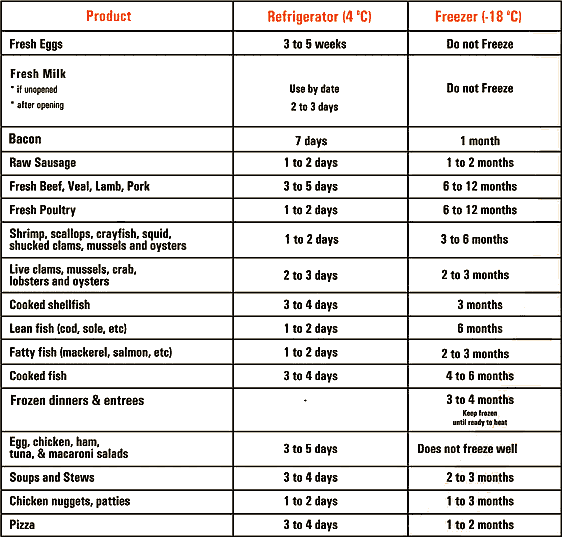
Wash and keep clean
Micro-organisms are everywhere in our environment - in the air, water, soil, in humans and animals. Harmful micro-organisms may be found on our hands, wiping cloths or food.
Washing and cleaning are simple measures that anyone can take to ensure food safety.
Tips:
- Wash your hands with soap and water before handling any food items or utensils.
- Wash your hands before and after preparing each type of food, especially raw meat and seafood.
- Wash your hands after using the toilet to get rid of gut bacteria.
- Wash and soak fruits and vegetables before eating.
- Clean all kitchen surfaces like countertops and cutting boards with soap and hot water.
- Wash knives, cutting boards and kitchen utensils between uses, and especially after using them to cut raw food.
- Wash dishcloths and tea towels frequently or use paper towels instead. Damp dishcloths and tea towels harbour bacteria.
- Disinfect kitchen sponges in chlorine solution or heat for 2 minutes in the microwave oven. Kitchen sponges can harbour millions of bacteria.
- Clean up as soon as possible. Do not let food residue dry on kitchen surfaces and utensils. It becomes more difficult to remove.
After shopping
- Return home directly after your shopping. You may want to bring insulated containers/cooler bags complete with ice or ice packs for the storage of chilled, frozen and other perishable food when you go shopping.
- Do not store chilled and frozen food directly in the boot of the car as the heat may cause the food to go bad.
Food safety when storing food
Keep cold food cold
Keep food outside of the temperature danger zone (between 5oC to 60oC), where bacteria multiply quickly.
- Keep cold food cold in the refrigerator, or on a bed of ice until it is time to serve.
Store dried food in a cool, dry place
Dried and preserved food should be stored in a cool and dry place, or kept in the refrigerator to prolong the shelf life. Warm and humid conditions can cause dried food to turn mouldy and rancid at a faster rate.
- Nuts can keep better and longer in airtight containers when stored in a cool, dry place away from light. It is best to keep them in an enclosed cupboard or in the fridge.
- Mouldy food should be discarded as it may contain harmful mycotoxins.
- Transfer dried foods that are bought loose or unused contents of opened packages of dried and preserved foods to airtight containers.
- Dried and preserved foods that will be kept for extended periods should be stored in packaging that does not allow entry of air or water vapor into the package to prevent rancidity or mouldy growth of food.
Handling Cooked Food
- Always try to cook just enough for the current meal.
- If you are cooking for more than one meal, apportion and keep the extra food in clean covered containers.
- Cooked food should be stored in the refrigerator or freezer once it is cooled.
- Do not eat cooked food directly out of the container. Always spoon out the portion you want to consume onto a separate dish to prevent contamination of the remainder.
Storing
- Store frozen meat in the freezer at -18oC.
- For storage of frozen meat in larger packaging, thaw the meat just enough (to about -10oC) to separate into smaller portions, then deep freeze in individual packs.
- Ensure there are sufficient space in-between items placed in the freezer or refrigerator so that cold air can circulate freely around them.
- Do not open refrigerator or freezer doors more often than necessary to minimise temperature fluctuation.
- Do not overstock your meat supply. Follow the rule of first in–first out, i.e. use older stock first.
Food Safety by Food Groups
Food Safety Tips By Food Groups
Here are some simple food safety tips on how to buy, handle and store the different types of food properly. More information can be found below:
- Meat
- Seafood
- Dairy Products
- Fruits and Vegetables
- Dried and Preserved Food
- Cooked Food
Meat
Keep Meat And Meat Products Safe!
Meat is a perishable food. When buying and handling meat, make sure that you keep the meat in a clean and cold condition until you are ready to cook it. Bacteria multiply quickly if the meat is placed in temperatures above 4°C. Refrigeration alone cannot guarantee the long shelf life of meat. Hygiene and packaging are very important as well.
The following tips will help you ensure that the meat you buy retains its quality and safety for consumption.
Buying meat
- Buy meat that looks fresh and has no sourish, stale or off odours.
- Only buy meat that is stored under proper refrigerated conditions.
- Choose meat that has no excessive moisture on the surface of the meat. Excessive moisture is an indication that the meat has not been handled or stored properly.
- Meat packages should not be damaged.
- Buy in quantities that meet your family's needs.
- Go home directly after buying meat so that it will not be left unrefrigerated for too long.
Handling meat
- Separate raw meat from cooked or ready-to-eat food to prevent cross-contamination.
- When handling meat, use separate cutting boards and utensils for raw meat and cooked food.
- After cutting raw meat, wash the cutting boards and utensils thoroughly with dish washing detergent and hot water.
- For frozen meat, thaw only the amount you need.Thaw frozen meat safely in the refrigerator or use the microwave oven.
- Chilled and thawed meat should be placed in the refrigerator if not cooked immediately.
- Do not re-freeze meat that has been completely thawed out in the refrigerator or meat that has been thawed in the microwave oven or in cold water.
- Do not leave chilled or thawed meat at room temperature for more than 2 hours as bacteria will rapidly multiply.
- Do not refreeze meat that has been completely thawed.
Storing meat
- Follow the recommended safe handling and storage information on the packages, if any.
- Ensure that there is sufficient space in between items placed in the refrigerator or freezer so that cold air can circulate freely around them.
- Do not open refrigerator or freezer doors more often than necessary to avoid temperature fluctuation.
- If you need to freeze the meat, divide into portions based on your normal serving size.
- Thaw frozen meat safely in the refrigerator or use the microwave oven.
- To avoid excessive evaporation, wrap the meat tightly in clean plastic bags before frozen storage.
- When storing or thawing meat in the refrigerator, place the meat in containers or trays to prevent the meat juices from contaminating other food.
- Prepared meat such as minced meat or meat cubes have shorter storage time.
- Do not overstock your meat supply. Follow the rule of first in / first out, i.e. use older stock first.
Your Storage Guide for Chilled Meat
|
| TYPE OF MEAT |
REFRIGERATOR (4oC) |
FREEZER (-18oC) |
| Bacon |
5 - 7 days |
1 - 2 months |
| Cooked Ham |
3 - 4 days |
1 - 2 months |
| Sausages |
1 - 2 days |
1 - 2 months |
| Beef / Veal |
3 - 5 days |
6 - 9 months |
| Lamb / Mutton |
3 - 5 days |
3 - 6 months |
| Pork |
3 - 5 days |
1 - 2 months |
| Poultry |
1 - 2 days |
1 - 3 months |
| Cooked Meatballs |
3 - 4 days |
1 - 2 months |
| Your Storage Guide for Frozen Meat |
| TYPE OF MEAT |
REFRIGERATOR (4oC) |
FREEZER (-18oC) |
| Sausages |
1 - 2 days |
1 - 2 months |
| Beef / Veal |
3 - 5 days |
4 - 12 months |
| Lamb / Mutton |
3 - 5 days |
6 - 9 months |
| Pork |
3 - 5 days |
4 - 6 months |
| Poultry |
1 - 2 days |
6 - 12 months |
| Meatballs |
|
|
| - raw |
1 - 2 days |
1 - 2 months |
| - cooked |
3 - 4 days |
2 - 3 months |
Seafood
Keep Seafood Safe For Your Family To Eat!
Singaporeans consume an average of 100,000 tonnes of seafood each year. While seafood is generally safe to eat, we can still take measures to minimise food safety risks through careful selection and handling.
Eating raw seafood instead of cooked seafood can makes us more prone to food poisoning. As such, those with poor immune systems should avoid taking raw or partially cooked seafood.
Big fishes, especially those higher in the food chain, may have higher mercury content. Such fishes can accumulate methylmercury in their flesh. This can affect an unborn child's nervous system. Expectant mothers and young children, who are more susceptible to the harmful effects of methylmercury, are advised to eat such seafood in moderate quantities and to maintain a balanced diet.
The following tips will enable you to enjoy safe seafood all year round.
Buying seafood
- Buy seafood that is properly iced or refrigerated.
- Select packaged seafood before its expiry date and check that packages are not torn.
- Fresh seafood should not have excess liquid when packaged.
- Avoid seafood that has a strong ammonia smell. Dead shellfish is not edible and should be avoided.
- When buying fish, choose those that are shiny, bright, and with scales intact. Fresh fish should have bright, clear and full eyes and firm flesh. Fish gills should be red to liver-red and free from slime.
- Head home immediately after buying seafood so that they will not be left unrefrigerated for too long.
Handling seafood
- Handle seafood with care. Bruises and punctures in seafood make them spoil more rapidly.
- Thaw seafood safely in the refrigerator or use the microwave oven.
- Separate raw seafood from cooked or ready-to-eat food to avoid cross-contamination.Thoroughly wash knives, containers and cutting boards before and after handling raw seafood.
- Scrub and clean the shells of scallops, mussels, clams or oysters under cold water before opening or cooking them in the shell.
- Always cook seafood thoroughly until it is opaque and flaky.
- Cook seafood well to kill viruses and bacteria.
Storing seafood
- Follow the recommended safe handling and storage information on the packages, if any.
- Wash and dry fresh seafood before placing them in clean plastic bags or containers for storage.
- If you need to freeze the seafood, divide into portions based on your normal serving size.Ensure that there is sufficient space in between items placed in the refrigerator or freezer so that cold air can circulate freely.
- Do not open refrigerator or freezer doors more often than necessary to avoid temperature fluctuation.
- When storing or thawing seafood in the refrigerator, place the seafood in containers or trays to prevent the juices from contaminating other food.
- Do not re-freeze seafood that has been completely thawed.
- Do not overstock your seafood supply. Follow the rule of first in / first out, i.e. use older stock first.
- Store live oysters, clams and mussels in the refrigerator. Keep them damp. Do not place them on ice, or let them come into contact with fresh water. Do not place them in airtight containers.
- Wash and refrigerate freshly shucked oysters, scallops and clams in separate containers. For best quality, they should be eaten immediately.
Your Storage Guide for Chilled Seafood
Your Storage Guide for Chilled Seafood |
| TYPE OF SEAFOOD |
REFRIGERATOR (4oC) |
FREEZER (-18oC) |
| Fish |
1 - 2 days |
2 - 4 months |
| Clams, Mussels, Oysters and Squids |
1 - 2 days |
3 - 4 months |
| Crabs, Crayfish, Prawns, Lobsters |
2 - 3 days |
2 - 3 months |
| Cooked Prawns and Mussels |
3 - 4 days |
2 - 3 months |
| Fishballs and Yong Tau Foo |
|
|
| - pre-packed |
Use by date |
Do not freeze |
| - loose |
1 - 2 days |
Do not freeze |
Your Storage Guide for Frozen Seafood
|
| TYPE OF SEAFOOD |
REFRIGERATOR (4oC) |
FREEZER (-18oC) |
| Fish |
1 - 2 days |
3 - 6 months |
| Prawns |
1 - 2 days |
9 - 12 months |
| Oyster |
|
|
| - shucked |
1 - 2 days |
3 - 4 months |
| - shelled |
1 - 2 days |
2 -3 months |
| Fishballs (cooked) |
3 - 5 days |
Use by date |
Dairy Products
Keep Dairy Products Safe!
Dairy products are rich in nutrients which are nourishing. However, these nutrients also encourage the growth of bacteria. SFA takes stringent measures to ensure that dairy products sold are safe for consumption.
As a consumer, you can play a part to help ensure food safety by buying dairy products from credible sources and observing good food safety practices.
Be a considerate shopper. Do not take chilled or frozen dairy products from chillers or freezers and leave them lying on shelves elsewhere in the supermarket as this compromises the safety and quality of the food. If you wish to return a chilled or frozen item, ensure that it is placed properly below the 'load line' in the chiller or freezer.
The following tips will enable you to enjoy safe dairy products all year round.
Buying dairy products
- Choose packages that are intact. Do not buy dairy products that are not properly sealed.
- Avoid canned dairy products that are dented, rusty, leaking or swollen.
- Check the expiry date on dairy products and do not buy items that are past their expiry date.
- For chilled dairy products, purchase only those that are properly displayed in the chillers. Chillers should be maintained at 4°C or below.
- Do not buy dairy products that have been stored or displayed beyond the 'load line'. The 'load line', usually applicable only in horizontal type chiller or freezer, indicates the level up to which food may be stored and kept at the correct temperature.
- Do not buy ice-cream that has excessive ice on the packaging as this indicates that it may have been partially defrosted and refrozen.
- Buy chilled and frozen dairy products last and head home immediately
- Do not place dairy products together with hot food in the same shopping bag.
Handling dairy products
- Take out only what you need to consume and return the unused portion to the refrigerator or freezer immediately.
- Do not leave dairy products at room temperature.
Storing dairy products
- Read the storage instructions on the label and keep the dairy products at the correct storage condition.
- Dairy products that can be kept at room temperature should be stored in a cool, dry place. Avoid storage under extreme heat or direct sunlight.
- Although Ultra Heat Treated (UHT) milk can be stored at room temperature until its expiry date, it should be kept chilled once it is opened and consumed within a week.
- Ensure that there is sufficient space in between items placed in the refrigerator or freezer so that cold air can circulate freely.
- Pasteurized milk should be kept refrigerated.
- Once a can of condensed or evaporated milk is opened, transfer its contents into a non-metallic container, cover tightly and refrigerate.
- Store butter and cheese in their original packaging in a covered non-metallic container and keep them refrigerated.
Fruits and Vegetables
Keep Fruits And Vegetables Safe!
Fruits and vegetables are a rich source of vitamins and minerals that offer many health and nutritional benefits. The following tips on buying, handling and storing will help you and your family enjoy maximum benefits from eating fruits and vegetables.
Buying fruits and vegetables
- Buy from reliable sources where you can be assured of quality.
- Choose fresh and clean produce. Select fruits with aromatic smell and vegetables with crispy, fresh leaves, as well as tender and fleshy stems.
- Avoid fruits and vegetables that are bruised, shriveled, blemished, spongy, or mouldy.
- The package used to store packed produce will help to retain freshness as well as minimise contamination and damage from poor handling.
- Place fruits and vegetables at the top of the grocery bags to prevent bruising.
- Head home immediately after buying fruits and vegetables. Keep them away from direct sunlight, heat or a hot environment (e.g. inside the car) to prevent wilting.
- Buy only what you can eat within a few days.
Handling fruits and vegetables
-
Remove the soiled portions of vegetables, cut off the base and wash away any residual soil in a basin of tap water.
-
Soak the vegetables in fresh tap water for 15 minutes. Special detergents or washes are not needed.
-
Before cutting and cooking, rinse the vegetables once more under a tap or in a basin of fresh tap water.
-
For harder items like potatoes, scrub the skin gently with a brush to get rid of any dirt.
-
To preserve the nutritional value, avoid cutting and shredding fruits and vegetables too early during preparation they may lose some of their nutrients when exposed to air.
Storing fruits and vegetables
-
Store fruits (except banana) and vegetables in the refrigerator as soon as possible.
-
Do not mix fruits with vegetables in the same storage compartment as fruits produce ethylene gas during their ripening process.
-
Remove any soil off vegetables (especially root vegetables) before storage.
-
Pack vegetables in plastic bags or containers before storing them in the vegetable compartment of the refrigerator.
-
Store hardy root vegetables and raw fruits that need ripening at room temperature.
A Buying and Storage Guide for Common Vegetables
|
| LEAFY VEGETABLES |
QUALITIES TO LOOK OUT FOR |
STORAGE LIFE |
| Baicai |
Dark green, thick broad leaves |
Up to 7 days |
| Bayam (Chinese spinach) |
Tender stems and leaves |
Up to 5 days |
| Caixin |
Big glossy leaves. Flowering caixin should have buds that have not bloomed |
Up to 7 days |
| Ceylon spinach |
Tender and fleshy stems with broad leaves |
Up to 7 days |
| Chinese white cabbage |
Compact and firm head with flat midribs. Free from black specks |
Up to 3 days |
| Gailan (Kai Lan) |
Powdery waxy thick leaves |
Up to 7 days |
| Kangkong (Water spinach) |
Tender stem without side shoots |
Up to 7 days |
| Lettuce |
Crisp and firm. Free from tip burn |
Up to 7 days |
| Peking cabbage |
Crisp and light green / yellow leaves |
Up to 5 to 7 days |
| Spinach |
Dark green, wrinkly but crisp leaves |
Up to 7 days |
| Xiaobaicai |
Big leaf with green and thickened leaf stalks |
Up to 7 days |
A Buying and Storage Guide for Common Vegetables
|
| NON-LEAFY VEGETABLES |
QUALITIES TO LOOK OUT FOR |
STORAGE LIFE |
| Bean |
Green and firm |
2 - 5 days |
| Broccoli |
Compact green head with no discolouration of bud clusters |
2 - 3 days |
| Capsicum |
Ripe, uniform colour, firm |
Up to 7 days |
| Cauliflower |
Compact head with no black spots |
Up to 7 days |
| Chilli |
Ripe, uniform colour, firm. Free from black spots |
Up to 3 weeks |
| Cucumber |
Light green, firm and smooth |
2 - 5 days |
| Egg plant (Brinjal) |
Uniform colour, firm, well shaped |
2 - 3 days |
| Head Lettuce |
Compact green head. Free from reddish brown spots and tip burn |
Up to 7 days |
| Okra (Lady's finger) |
Well shaped, tender with tip readily broken when snapped |
2 -3 days |
| Tomato |
Ripe, firm, regular shape, uniform colour |
Up to 7 days |
Dried and Preserved Food
Keep Dried And Preserved Food Safe!
Dried and preserved foods such as barbequed meat, sausages, meat floss, nuts and lotus seeds, and preserved fruits like dates and mangoes are common in Singapore. While we enjoy these food, they can be unsafe to eat if they become mouldy or contaminated by harmful bacteria.
As a consumer, you can do your part to minimise your health risks by choosing dried and preserved food that is properly packaged. Always check that the food is in good condition before consumption.
The following tips will enable you to enjoy safe dried and preserved food all year round.
Buying dried and preserved food
- Choose dried and preserved food that are properly packaged. Do not buy any packets that have been damaged or opened.
- Do not buy mouldy food as they may contain mycotoxins.
- Do not buy food with insect infestations.
- For unpacked dried and preserved food, take note of the personal hygiene of the seller, the environmental hygiene of the retail establishment and the cleanliness of the container.
- Buy only from credible sources.
Handling dried and preserved food
- Do not taste food that show signs of spoilage.
- Inspect dried and preserved food regularly for insect infestations, mouldiness and other signs of spoilage. Discard when necessary.
Storing dried and preserved food
- Store unopened dried and preserved food in a cool and dry place, away from heat or direct sunlight.
- Dried and preserved food that are to be kept for extended periods of time should be stored in packaging that does not allow air or water vapor into the package to prevent rancidity or growth of moulds.
- Once a pre-packed dried and preserved food is opened, transfer the unused portion to air-tight containers and keep them in the refrigerator to maintain their quality.
- Do not overstock your food supplies. Rotate your supplies of dried and preserved food by using the oldest first - follow the rule of first in / first out.
Cooked Food
Keep Cooked Food Safe!
Food poisoning can occur as a result of using improper food handling practices when storing and reheating cooked food. Follow these food safety tips to reduce the risk of food poisoning from contaminated cooked food.
Handling cooked food
- Cook only sufficient amounts for immediate serving.
- Portion out excess cooked food after cooking and refrigerate quickly.
- Cooked food intended for consumption later should be separated from food to be served as soon as it is cooked.
- Do not try to chill or cool down hot food in large quantities. This is because large quantities of food would take a longer time to chill properly.
- Buy only from credible sources.
Storing cooked food
- All cooked food should be refrigerated or frozen within 2 hours after cooking.
- Store cooked food in a clean, shallow container.
- Use shallow containers and leave sufficient air space around the food to promote rapid and even cooling. Cooked food stored in large, deep containers remain warm for a longer time. Dangerous bacteria may grow in this warm spot which can lead to food poisoning if consumed.
- When freezing cooked food, make sure they are wrapped tightly.
- Keep your refrigerator uncluttered so that air can circulate and cool food properly.
- Do not refreeze frozen food that have been thawed.
- As a general rule, do not keep cooked food for more than 4 days.
Throwing out cooked food
- Label and date food before storing them. This eliminates questions as to the age of the food.
- If there is any doubt about the safety of the food, throw it out.
Safe Use of Plastic Food Packaging
What are plastics?
Plastics are used in the manufacture of a wide range of food packaging and containers. Food packaging keeps food safe from contamination and from damage during distribution while providing fresh food for consumers. Plastic containers such as cups, plates, bowls and bottles offer a range of lightweight and unbreakable kitchenware for our daily household use. The diversity of properties of plastics allows them to perform many of the necessary tasks.
Plastics are made from long chain polymers and each polymer is composed of small building units called monomers that are chemically linked together. Different combinations of monomers yield polymers with different properties and characteristics. In addition, plastic additives are incorporated into polymers during the manufacturing process to confer specific properties to the polymer for certain packaging applications. For example, the introduction of nucleating agents improves the clarity and stiffness of a plastic polymer which allows it to be used for making rigid and clear containers that show-off the contents and appeal to consumers.
Plastic identification codes
There are seven groups of plastic polymers, each with specific properties that are used worldwide for many packaging applications (see table below). Each group of plastic polymer can be identified by its Plastic Identification code (PIC) - usually a number or a letter abbreviation. For instance, Low-Density Polyethylene can be identified by the number "4" and/or the letters "LDPE". The PIC appears inside a three-chasing arrow recycling symbol (see table). The symbol is used to indicate whether the plastic can be recycled into new products.
The PIC was introduced by the Society of Plastics Industry, Inc. which provides a uniform system for the identification of different polymer types and helps recycling companies to separate different plastics for reprocessing. Manufacturers of plastic food packaging and containers can voluntarily mark their products with the PIC. Consumers can identify the plastic types based on the codes usually found at the base or at the side of the plastic food packaging and containers. The PIC is usually not present on packaging films, as it is not practical to collect and recycle most of this type of waste.
| Plastic Identification Code |
Type of plastic polymer |
Properties |
Common Packaging Applications |
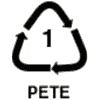
|
Polyethylene Terephthalate (PET, PETE) |
Clarity, strength, toughness, barrier to gas and moisture. |
Soft drink, water and salad dressing bottles; peanut butter and jam jars
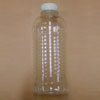
|
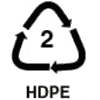
|
High Density Polyethylene (HDPE) |
Stiffness, strength, toughness, resistance to moisture, permeability to gas. |
Milk, juice and water bottles; yogurt and margarine tubs; trash and retail bags.
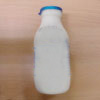
|
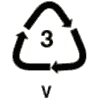
|
Polyvinyl Chloride (V) |
Versatility, clarity, ease of blending, strength, toughness. |
Juice bottles; cling films
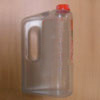
|
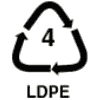
|
Low Density Polyethylene (LDPE) |
Ease of processing, strength, toughness, flexibility, ease of sealing, barrier to moisture. |
Frozen food bags; squeezable bottles, e.g. honey, mustard; cling films; flexible container lids.
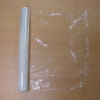
|
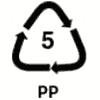
|
Polypropylene (PP) |
Strength, toughness, resistance to heat, chemicals, grease and oil, versatile, barrier to moisture. |
Reusable microwaveable ware; kitchenware; yogurt containers; margarine tubs; microwaveable disposable take-away containers; disposable cups and plates.
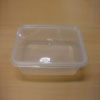
|
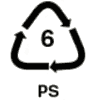
|
Polystyrene (PS) |
Versatility, clarity, easily formed |
Egg cartons; disposable cups, plates, trays and cutlery; disposable take-away containers; yoghurt and margarine containers
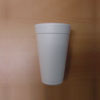
|
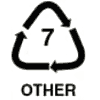
|
Other |
Dependent on polymers or combination or polymers. |
Beverage bottles; baby milk bottles.
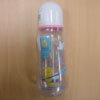
|
Migration of chemicals from plastics
Chemicals that are used in the manufacture of plastic packaging or containers can migrate into foods during use. The quantities of migrating chemicals will depend largely on the nature of food, the contact temperature and the contact time. However, proper usage of the plastics will have insignificant or very low levels of chemical migration, which does not pose any health risk to consumers even after long-term use.
Legislation
Both the US and the European Union (EU) have very complex regulations covering the authorized chemicals including monomers that can be used in the manufacture of plastic packaging and containers. When necessary, these regulations also establish restrictions such as migration limits, on the use of these chemicals. The principles behind the regulatory rules of other countries are similar to those of the EU and US in that the plastic packaging material shall be in compliance with their national safety regulations or guidelines. To safeguard our consumers' health, the Singapore Food Regulations also stipulate that all food packaging imported for use in Singapore do not migrate any harmful substances to the food coming in contact with the packaging.
The responsibility to ensure safety compliance is with the producers of the plastic packaging material who have to conduct prior use tests on their products to ensure that they comply with the relevant legislation. National regulatory authorities may conduct tests and surveys on plastic food packaging to verify that their safety is being maintained. The Singapore Food Agency (SFA) of Singapore also conducts safety assessments to ensure that the plastic food packaging and containers available on the market are safe for their intended use.
Safety tips for consumers when using plastic food packaging & containers
When manufacturers design a plastic packaging, they will take into consideration the type of food and its contact time with the packaging, and the amount of heat to which the plastic will be subjected. It is therefore crucial that consumers do not misuse packaging materials in an unintended or unanticipated manner as this may result in greater amounts of chemical migration than would otherwise be expected. The following are some guidelines for safe use of plastic food packaging and containers.
Plastics and conventional oven
- Unless indicated otherwise, plastic packaging used for commercial packing of food is not suitable for use in conventional ovens. They may catch fire or melt and resulting in chemical migration into foods.
- Reheat pre-cooked foods in a conventional oven only if they are sold in specially made "ovenable" packaging and oven reheating instructions are given by the manufacturer.
Plastics and microwave oven
- Only use plastic containers that are labeled as microwave-safe for microwave cooking or reheating. Do not use the container in a microwave oven if you are in doubt or unable to find the manufacturer's instructions for microwave use.
- Cold or freezer storage containers such as yoghurt, margarine and ice-cream tubs are not manufactured for reheating or cooking food in a microwave or conventional oven. They are not heat stable and chemicals from the plastic may migrate into the food during heating.
Plastic cling films
- Do not use cling films in conventional ovens or with pots and pans on cooker hobs where the films may melt into the food.
- Always follow the manufacturer's instructions on the proper usage of the cling films.
- Only use cling films designated as suitable for use in microwave oven.
- When re-heating or cooking food in a microwave oven, ensure that the microwave-safe cling film does not touch the food. If the film touches the food, the film could get overly hot and possibly melt or may migrate chemicals into the food.
Freezing, defrosting and cooking fresh produce in commercial plastic packaging
- It is safe to freeze meat directly in its original commercial plastic wrapping. For long storage, rewrap or over-wrap the meat tightly with moisture proof freezer bags to maintain the quality and texture of the meat.
- Do not defrost or cook the meat in its original commercial packaging in a microwave oven, as the plastic packaging may not be microwave-safe.
Reusing plastic packaging and containers
- Commercial plastic packaging that has been used for storing non-food items (e.g. detergents) should never be reused as food containers. They have not been tested safe for food storage and they may contain non-food residues that contaminate food.
- Plastic packaging that are used for commercial packing of food and takeaway plastic food containers used in eating outlets are disposable items designed for single use and are not intended for repeated storage of food. They are safe for their immediate intended purpose but not beyond what they are designed for.
- Only use those takeaway food containers that are labeled microwave-safe for reheating food in the microwave oven. They should not be reused for microwave heating.
- Plastic packaging for microwaveable convenience meals are designed for one time usage with the type of food packed in it and should not be reused for storing or microwave heating of food.
- Only use reusable plastic food containers (e.g., cups, plates, bowls, bottles and boxes used in household kitchens) for repeated storage of food. These containers have the sturdiness, thermal stability and other attributes needed for a reusable food container.
- Reusable plastic food containers can be subjected to wear and tear after a period of use. They should be replaced when they have turned cloudy or discoloured or if cracks or heavy abrasions start to appear.
Safe use of polycarbonate baby bottles to reduce your baby's exposure to bisphenol-A :
(a)Do not put boiling water in baby bottles, as hot water causes bisphenol-A to migrate out of the bottle at a higher rate.
(b)Boiled water should be allowed to cool to lukewarm in a non-polycarbonate container before transferring to baby bottles.
(c)Baby bottles can be sterilized according to instructions on infant formula labels and should be allowed to cool before placing infant formula into them.
(d)Parents who are concerned about using polycarbonate baby bottles can turn to other alternatives such as glass bottles.